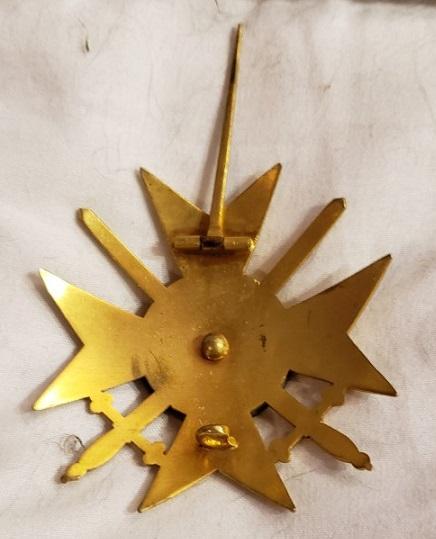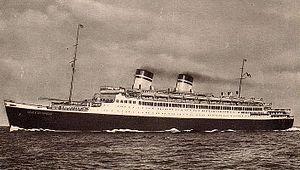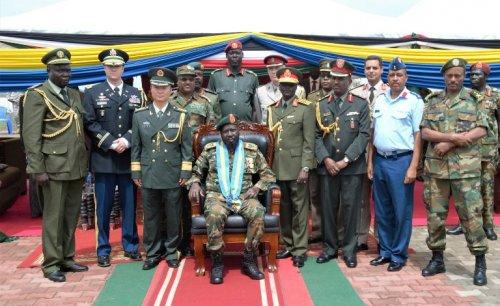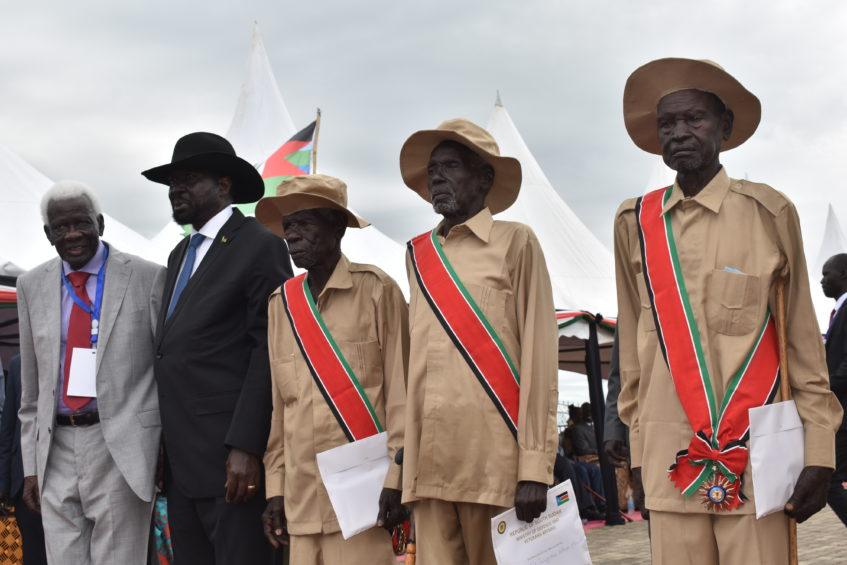
922F
-
Posts
1,380 -
Joined
-
Last visited
-
Days Won
7
Content Type
Profiles
Forums
Blogs
Gallery
Events
Store
Posts posted by 922F
-
-
Many tailors/technicians who assembled/mounted award bars used whatever scrap or spare ribbon to hand when mounting awards themselves to bars. Then they added the correct ribbon formed into the familiar shape around the award. While the correct ribbon may appear as the award mounting material, most bars I've seen with backing loose or removed display an assortment of varying ribbons or narrow strips of white/gray edge bound narrow cotton tape type material used for that purpose.
This to indicate that the color of the red/green ribbon seen protruding beneath the KVK may have nothing to do with the item originally placed there.
White with red central stripe ribbon could well be an Ottoman Red Cross [KVK & Verdienstkreuz für Kriegshilfe could support this proposition] or maybe a Spanish MMO, white distinction. In either case, odd that it appears where it does.
0 -
Ideal that you found a ribbon, case and mini! Is the case marked Garrard, Spink or ...?
From time to time issued cravats [both narrow, wide and, very rarely, 55 mm - 2 1/8 inch wide] appear on UK ebay or in dealer stock.
0 -
Above crown format usually associated with insignia related to various Christian Eastern Orthodox/Melkite Orders [c.f. Patriarchal Order of the Holy Cross of Jerusalem] and "international" Order groups [c.f. Imperial Order of St. Eugene of Trebizond] these latter usually claiming a relationship with or descent from the Byzantine Empire. Sometimes this type of insignia uses a typical Bulgarian Czarist design suspension crown.
0 -
Hildegarde Maria Slock-Cottell image found at http://www.caulfeild.co.uk/individual.php?pid=I121&ged=Caulfeild. She held a Belgian Leopold I knight as well, perhaps suggesting that her St. Sava was more than a protocol award.
0 -
Japanese officers received various French colonial Orders including at least the Royal Order of Cambodia, Dragon of Annam, and Nichan Iftikir besides the Black Star of Benin. Images of naval personnel, for example, wearing such may be located via: https://www.wikiwand.com/en/List_of_Imperial_Japanese_Navy_admirals. Without in-depth research, hard to say whether some of these awards were protocol awards, recognition for service rendered in respective geographic areas, naval visit honors exchanges, or ???? Images at the website mentioned appear to show concentrations of these colonial decorations in the 1890's and WW I era but a couple seem to be in the 1930's.
Do not forget that during WW II Japanese personnel received both Cambodian and Annamese honors from the king and emperor, French collaborationist governments and possibly the Japanese controlled puppet states.
During and post WW II, the Black Star of Benin and Ouissan Alaouite were likely the most usual colonial orders used to 'protect' the Legion of Honor but examples when other colonial orders fulfilled this role exist.
0 -
Hello Owain,
Ambassador Abebe's group certainly has found an excellent home. Thank you for sharing this enlightening information!
0 -
Has anyone information on the MBE/OBE manufacturer activity periods? Garrard examples seem to be earliest [1917-?], then Royal Mint [19??-197??] then contractors like Spink, Toye, Kenning & Spenser, Gladman & Norman Ltd, Worcestershire Medal Service and ???
0 -
Hans-Georg Steltzer (born April 30, 1913 in Braunschweig, died April 12, 1987 in Königswinter), a German soldier, diplomat and writer, served in the Wehrmacht being promoted to major by 1945. Steltzer later became a career Social Democratic Party of Germany politician/bureaucrat. Among his duties, he headed the Federal Press Office in the Foreign Office and worked as a diplomat in Africa and at home. Steltzer left government in 1978-79 but remained active in foreign affairs, especially regarding Africa. He published several books on German-African colonial relations and the Imperial German Fleet. Steltzer served as German ambassador to Egypt and Ghana and received many awards including, at least,:
Germany [Federal Republic] Order of Merit, 3rd class;
Cameroun Order of Merit, First Class [sash/badge];
Egypt Order of Merit, [Grand Cordon?];Gabon Order of Merit, Grand Officer;
Ghana [Order of Volta?, class unknown];
Ivory Coast Order of National Merit, Commander;Liberia Order of African Redemption, Commander;
Madagascar Order of National Merit, Grand Officer;
Niger Order of Merit, Grand Officer;
Senegal Order of National Merit, Commander.Tunisia Order of the Republic, Grand Officer.
Has anyone additional information regarding Steltzer's Wehrmacht service [and possible awards]? Is this list of his post-war decorations accurate and complete? Thanks for your assistance!
0 -
Cannot determine whether circlet of 'dots' within the central rim are individually crisp & equally spaced. That said, looks OK, note ring suspension attachment & lack of casting marks. C.F. http://www.cimilitaria.com/Danzig Cross.html and other sites.
0 -
Pink & White....sure looks like a Brazil Imperial Order of the Rose but maybe here representing a Hesse-Darmstadt award c. f. Distinguished Service Kriegsehrenzeichen 1916-18, War Aid medal, Ehrenzeichen für Kriegsfürsorge 1916-18, Military Medical Cross (Militär-Sanitäts-Kreuz--metallic silver stripes), 1914 or Long Service Award. All have a darker red color value and slightly different proportions.
Another German State possibility escapes recollection for the moment.
0 -
Hello New World,
I reviewed the one photo I have of Tudor Petrov and could not be sure if he was my man. Do not have a photo of Professor Pavlov. Probably the apartment location will be key to identifying him.
After my first visit to Bulgaria in 1979, I often had 'minders' intermittently keeping track of me. After 5-6 visits, they knew my routine and usual activities. This did result in no longer meeting some in their homes but always in public places, parks, bars... I visited only two people in their apartments regularly over the years. I'm sure that the gentleman I visited most often had excellent connections/protection, not only due to the apartment and collection. He definitely had access to top level privileges. Maybe because I was a foreigner he felt able to display his collection [and sell a few things]?
I suspect, even not being overly paranoid, that any Bulgarians I had contact with sometimes 3 times a year over almost 20 years [1979-1999] could expect DS interest. Someone who would be 'allowed' to see me at home must have had strong political social connections. Certainly some members of the Club and some antique dealers were obviously looking for foreigners, especially Germans. I do not speak German but would constantly be addressed in German. And this by the same people over 6-8 years!
0 -
Thank you New World for all of this fascinating information! The apartment I visited was not down by the Russian Church but near the Palace of Culture Park, maybe 3 blocks northeast from the Park. The building architecture was somewhat similar but maybe 5-6 stories tall with at least one small one bedroom apartment on the roof. Entry was in the middle of the front facade of the building. It was on the right side of the street, most likely on Bvd. Skobelev, as you face the park.
There were a large number of filled bookshelves in main apartment rooms that I saw. I recall there were a number of art works on the walls but didn't pay attention to them.
The main room upstairs was quite full of cabinets and boxes. Cases on the wall displayed decorations, mainly Socialist awards and Military Bravery crosses. I well remember among other treasures kept in cabinets a large cased Cyril & Methodius collar, a cased C & M set in the blue case with silver-gilt/enamel crown on lid [first year issued, supposedly] and a St. Alexander collar set with military badge & star. The gentleman had a large wooden desk that seemed as if it took about 1/4 of the room space and a very comfortable overstuffed chair for guests. In good weather, you could sit at a table out on the roof. He had silverware from one of the palaces, think with Ferdinand's monogram.
We originally met at the Saturday Club for coins and medals off Tsar Boris I and Han Asparuh Streets. The apartment was a few blocks from the Club. I met a number of other collectors at Club; we sometimes went to the park by St. George's to discuss 'trades'. After several visits, some of them invited me to their homes, usually out in apartment blocks beyond the train station. The Club meeting moved to a different location near a large park some years later.
From the news stories, [if it was Raynov] I wonder if the place I visited was one of his 'hideaways' or in someone else's name. That might explain why when I visited without meeting at Club first, I had to arrange an appointment by 'public' telephone in advance.
0 -
Thank you, Graf!!!
I will continue searching for the obverse image of this star.
I looked at images of Bogomil Raynov but just do not remember the face well enough. The man that I knew almost always smiled and was, as the French say, très très sympa. Raynov's expression in images found on the Internet appear quite dour. My acquaintance certainly had complete understanding of royal Bulgarian and foreign awards. His collection included any number of 'classic' European decorations in addition to the full range of Bulgarian material.
There was a small staircase in his main apartment that led up to the upper one so one did not have to go outside. We drank Chateau d'Euxinograd wine which was extremely difficult to find in Sofia at the time. A sort of concierge who did not appear to be a typical guard attended the entry of the building; you had to have permission to enter.
If someone knew Raynov's address and remembers the upper apartment, that might settle the matter. Cannot imagine many Bulgarians having such an arrangement in 1980!
0 -
Thanks to all. Graf, I appreciate your clarification regarding the sword hilt.
I mentioned above a 1995 image of a reverse with round 'button' fitting. Found it but the picture dates from a visit to Sofia in 1980!!! The 'button' height was about 1.25 mm. Sorry, cannot find photo of obverse or the owner's name at present. Has anyone seen a definite genuine piece with such a button'?
The owner had an enormous collection and lived on the top floor of a very exclusive building on what is now Boulevard General Mihail D. Skobelev or Boulevard Pencho Slaveykov maybe 3 blocks from the National Palace of Culture Park. [I'm not only confused about dates but locations too!] He had a small apartment on the roof of the building that housed his collection. He was about 55-60 years old in 1980, last visited him in 1987 or '88. Most likely, he either had very good connections in the government or was an official. He spoke English and French besides Bulgarian and Russian at least. Perhaps someone here remembers him?
0 -
Yes, thank you, New World
0 -
Thank you Graf! I am a bit surprized that the left sword hilt on the genuine piece has a stippled pattern rather that a knurled one. Is the reverse fastener a simple nut or a rivet type nut? I do not have mine to hand to compare.
Somewhere I have an image made about 1995 of one with a rounded type fitting at the reverse center.
0 -
Somewhere here, if I remember correctly, there is a post describing fake first class 68 mm. Bravery Order stars. Wasn't the most obvious characteristic the reverse rivet fastener? I can't find that post could someone refer to it please?
0 -
Probably gold badge if relatively light weight, otherwise silver gilt with maybe gold centers.
Gazzetta Ufficiale del Regno d'Italia N. 131 del 8 Giugno 1932
Sabelli ing. Emilio, capo ufficio progetti del Cantiere San Marco
[Sabelli engineer Emilio, head of the projects office of the San Marco shipyard]
Likely employed at Stabilimento Tecnico Triestino. Originally an Austro-Hungarian yard mainly building warships. Post WW I to Italian ownership building naval and commercial ships. Sabelli's award perhaps connected to 1932 launch of famous Italian liner SS Conte di Savoia.
0 -
Little information regarding Southern Sudanese awards seems available other than a few images and information snippets. President Salva Kiir Mayardit (in office since 2011 & First Vice President of Sudan, from 2005 to 2011) wears awards in two images shared below. [Besides Sudanese and Southern Sudanese decorations the President probably has received foreign honors.] His Stetson hat is a sort of personal emblem or trademark, stemming from a visit to the U.S.A., not a Southern Sudanese traditional Archetype.
A news release indicates that President Kiir, the commander-in-chief of SSPDF– received medals on the recommendation of the 5th Command Council Conference held in Juba in 2016. The Chief of General Staff presented him with the Medal of National Heroism, Medal of Bravery, Medal of Independence, and medal of Long Service Conduct, the medal for Distinguished Military Service, Medal of Counter Insurgency and Medal of Combat Proficiency. The first image below may illustrate some of these awards.
The second image pictures Kiir with domestic and foreign military officers. He wears a blue-white-blue sash similar to the Somali Order of the Leopard or the inactive Tadjoura/French Order Nichan el-Anouar.
Last image depicts Kiir with veterans he decorated on 5 September 2017 with what appears to be simply a badge & sash. Unfortunately no info other than " President Kiir, who is also a core member of the SPLA rebellion, is awarding them medals for their heroism during the Liberation Struggle [1983-2005] at the military headquarters in Bilpam."
Further news on this topic welcome!
1 -
Indeed, the most difficult to find--sincere congratulations!!!
0 -
Thank you for this information...perhaps his foreign awards resulted from coordinating investigations or teaching criminal justice matters or other international police cooperation matters. NCB Netherlands' history reveals much involvement in such matters.
0 -
The hallmark possibly would provide a date range depending on what it is. Judging by enamel work, maybe 1900-1930 manufacture. Suspension wreath type similar to Black Star of Benin dating to that period and used maybe as late as the early 1950's.
0 -
Examine hallmark on reverse suspension lug--that should reveal clues to source. Punch shape suggests possible Austrian or French manufacture. Look at ring as well for marks. Possibly made with struck motto rings & centers [or replacement centers] now simply displaying wear and oxidation. Champlevé work behind Gregory's head looks French. Not that the case necessarily was supplied with the decoration initially but it's general appearance looks to be of typical Bertrand, Bacqueville & similar origin.
A fine example, in my opinion!
0 -
First image looks like Delhi Durbar Medal of 1911 which Haig held. 2nd so muddled could be Saxe Ernestine Order {HAH!}
0





.jpg.42009921ca89bafc8a8f401db9e5711e.jpg)


Help with original medal ribbon
in Germany: Imperial: The Orders, Decorations and Medals of The Imperial German States
Posted
You may wish to contact http://www.ribbonsshop.com/austria-republic/au292-austria-order-of-the-knights-of-malta-ribbon-for-merit-crosses-and-medals/ for a replacement. Besides what's listed on-line, they have some old stock not always shown on their website. Teo Toussaint now manages Ribbonshop.